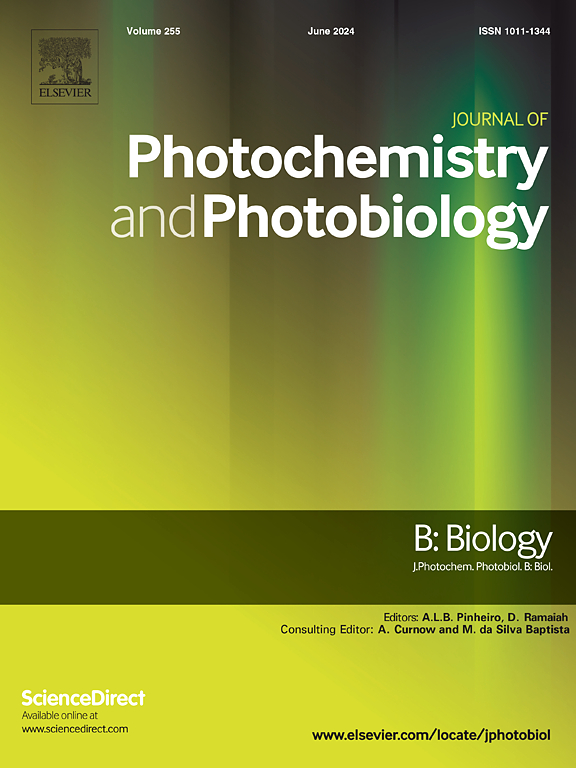波长依赖性光生物调节在体外肠道模型中对肠道炎症的治疗潜力
IF 3.7
2区 生物学
Q2 BIOCHEMISTRY & MOLECULAR BIOLOGY
Journal of photochemistry and photobiology. B, Biology
Pub Date : 2025-06-18
DOI:10.1016/j.jphotobiol.2025.113201
引用次数: 0
摘要
近年来,光生物调节(PBM)已成为一种调节肠道微生物组的新治疗方法,为调节肠道炎症提供了潜力。虽然PBM主要用于各种临床应用,但最近的研究表明,其作用可能扩展到调节微生物失衡和慢性炎症。PBM的生物效应与波长有关,因为光的波长决定了组织穿透深度和细胞反应。本研究旨在比较四种不同波长(405、532、635和808 nm)下PBM的炎症调节作用,并阐明PBM在肠道炎症中的潜在分子机制。建立Caco-2细胞与乳酸菌体外共培养模型,模拟肠道环境。通过脂多糖(LPS)刺激诱导细胞炎症,然后进行波长依赖的PBM处理,剂量为10 J/cm2 (100 mW/cm2,单次照射100 s)。在这些波长中,635 nm显著降低了一氧化氮的产生,抑制了促炎细胞因子(TNF-α、IL-6、IL-1β和iNOS)的表达。此外,western blot和qPCR分析显示,635 nm PBM下调MAPK/NF-kB通路中的关键信号因子,提示其抗炎作用的潜在分子机制。这些发现表明,特别是在635 nm处,PBM可能是调节肠道炎症的有效策略。进一步的研究将在炎症性肠病的体内模型中研究PBM的抗炎症和微生物组调节作用。本文章由计算机程序翻译,如有差异,请以英文原文为准。
Therapeutic potential of wavelength-dependent photobiomodulation on gut inflammation in an in vitro intestinal model
Recently, photobiomodulation (PBM) has emerged as a novel therapeutic approach for modulating the gut microbiome, offering potential for the regulation of intestinal inflammation. Although PBM has been primarily used for various clinical applications, recent studies suggest that its effects may extend to the regulation of microbial imbalances and chronic inflammation. The biological effects of PBM are wavelength-dependent, as the wavelength of light determines tissue penetration depth and cellular response. The current study aimed to compare the inflammation-modulatory effects of PBM at four different wavelengths (405, 532, 635, and 808 nm) and to elucidate the underlying molecular mechanisms of PBM in intestinal inflammation. An in vitro co-culture model consisting of Caco-2 cells and Lactobacillus was established to simulate the intestinal environment. Cellular inflammation was induced by lipopolysaccharide (LPS) stimulation, followed by wavelength-dependent PBM treatment at a dosage of 10 J/cm2 (100 mW/cm2 for 100 s, applied as a single irradiation). Among the wavelengths, 635 nm significantly reduced nitric oxide production and suppressed the expression of pro-inflammatory cytokines (TNF-α, IL-6, IL-1β, and iNOS). Furthermore, western blot and qPCR analyses revealed that 635 nm PBM downregulated key signaling factors in the MAPK/NF-kB pathway, indicating a potential molecular mechanism for its anti-inflammatory effect. These findings suggest that PBM, particularly at 635 nm, may serve as an effective strategy for modulating intestinal inflammation. Further studies will investigate the anti-inflammation and microbiome modulation effects of PBM in an in vivo model of inflammatory bowel disease.
求助全文
通过发布文献求助,成功后即可免费获取论文全文。
去求助
来源期刊
CiteScore
12.10
自引率
1.90%
发文量
161
审稿时长
37 days
期刊介绍:
The Journal of Photochemistry and Photobiology B: Biology provides a forum for the publication of papers relating to the various aspects of photobiology, as well as a means for communication in this multidisciplinary field.
The scope includes:
- Bioluminescence
- Chronobiology
- DNA repair
- Environmental photobiology
- Nanotechnology in photobiology
- Photocarcinogenesis
- Photochemistry of biomolecules
- Photodynamic therapy
- Photomedicine
- Photomorphogenesis
- Photomovement
- Photoreception
- Photosensitization
- Photosynthesis
- Phototechnology
- Spectroscopy of biological systems
- UV and visible radiation effects and vision.

 求助内容:
求助内容: 应助结果提醒方式:
应助结果提醒方式:


